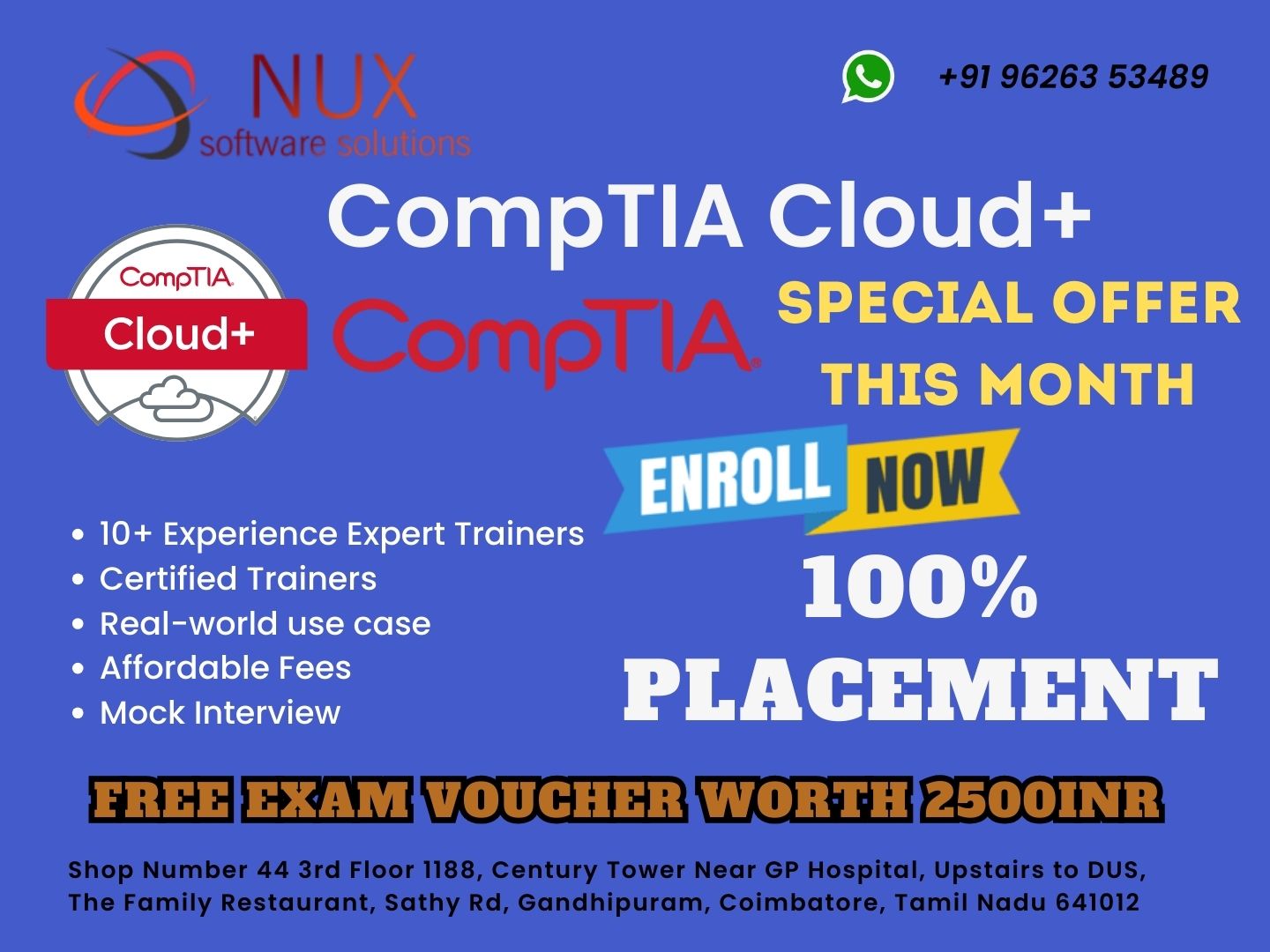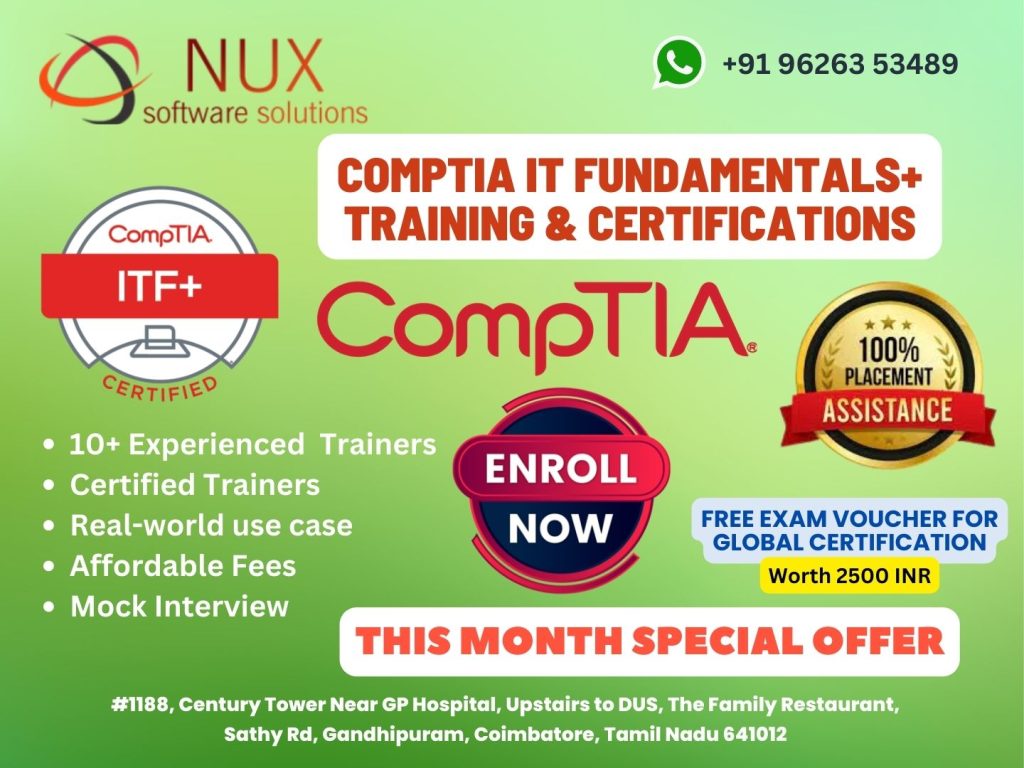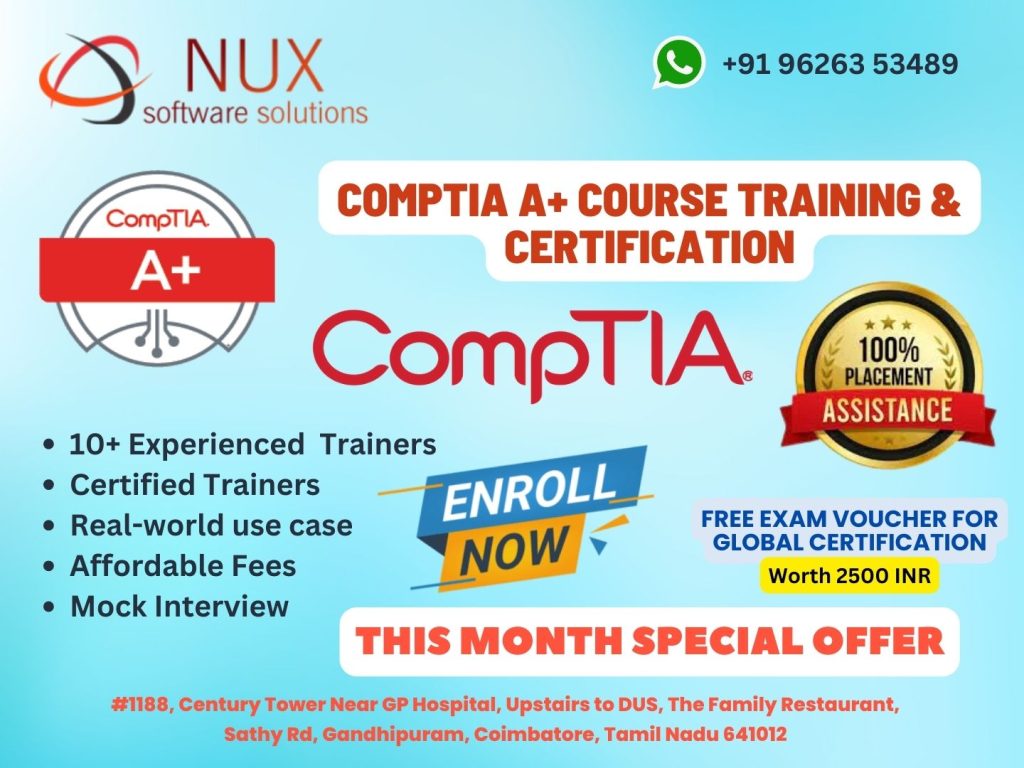CompTIA Cloud+ Training and Certification

Course Overview
The CompTIA Cloud+ certification is a globally recognized, performance-based credential designed for IT professionals who are responsible for deploying, securing, managing, and automating cloud infrastructure services. It validates the technical skills needed to operate in today’s multi-cloud and hybrid cloud environments across platforms like AWS, Microsoft Azure, and Google Cloud.
Unlike vendor-specific certifications, Cloud+ offers vendor-neutral cloud expertise, making it an ideal choice for professionals seeking a broad, foundational understanding of cloud computing. This certification focuses on cloud architecture, deployment, operations, security, troubleshooting, and automation, all within real-world scenarios.
At our training center in Coimbatore, students gain in-depth knowledge of virtualization, high availability, disaster recovery, cloud storage, performance tuning, and cloud security. The course prepares candidates to confidently pass the CompTIA Cloud+ CV0-003 exam and thrive in enterprise-level cloud roles.
Who Should Take This Course?
Cloud Engineers
System and Network Administrators
Cloud Support Specialists
DevOps Engineers
IT Infrastructure Professionals
Key Course Features
Comprehensive training aligned with CompTIA Cloud+ CV0-003 objectives
Hands-on labs with AWS, Azure, and Google Cloud environments
Expert instructors with real-world cloud deployment experience
Cloud security, automation, and orchestration modules included
Full exam preparation with practice tests and guidance
Career Roles After Certification
Cloud Systems Administrator
Cloud Operations Engineer
Cloud Infrastructure Engineer
Cloud Security Analyst
IT Systems Engineer – Cloud
Why Choose Our Cloud+ Training?
Real-world labs for public, private, and hybrid cloud environments
Training beyond the certification—focused on job readiness
Flexible scheduling options: weekday, weekend, and online sessions
Support for resume building, mock interviews, and career planning
Globally valued certification for professionals managing enterprise cloud infrastructures
Step confidently into the future of IT by mastering cloud infrastructure, automation, and security with CompTIA Cloud+.
CompTIA Cloud+ Syllabus
Modules
Compare and contrast cloud services.
1. SaaS (according to NIST), 2.IaaS (according to NIST), 3.PaaS (according to NIST), 4. CaaS, 5.XaaS, 6. DaaS, 7. BPaaS, 8. Accountability and responsibility based on service models,
Compare and contrast cloud delivery models and services.
Explain object storage concepts.
Explain the differences between hypervisor types.
Install, configure and manage virtual machines and devices.
Given a scenario, perform virtual resource migration.
Explain the benefits of virtualization in a cloud environment.
Compare and contrast virtual components used to construct a cloud environment.
Compare and contrast various storage technologies.
Explain storage configuration concepts.
1. Private, 2. Public, 3. Hybrid, 4. Community, 5. On-premise vs. off-premise hosting, 6. Accountability and responsibility based on delivery models, 7. Security differences between models, Multi-tenancy issues, Data segregation, Network isolation, Check laws and regulations, 8. Functionality and performance validation based on chosen delivery model, 9. Orchestration platforms,
ZFS
Execute storage provisioning.
1. Object ID, 2. Metadata, 3. Data/blob, 4. Extended metadata, 5. Policies, 6. Replicas, 7. Access control,
Given a scenario, implement appropriate network configurations.
1. Elasticity, 2. On-demand self-service/just-in-time service, 3. Pay-as-you-grow, 4. Chargeback, 5. Ubiquitous access, 6. Metering resource pooling, 7. Multi-tenancy, 8. Cloud bursting, 9. Rapid deployment, 10. Automation
Explain the importance of network optimization.
Given a scenario, troubleshoot basic network connectivity issues.
Explain common network protocols, ports and topologies.
Explain common hardware resources and features used to enable virtual environments.
1. Type I and Type II, Bare metal vs. OS dependent, Performance and overhead considerations, Hypervisor-specific system requirements, 2. Proprietary vs. open source, 3. Consumer vs. enterprise use, Workstation vs. infrastructure,
Resource Management
Given a scenario, appropriately allocate physical (host) resources using best practices.
Given a scenario, appropriately allocate virtual (guest) resources using best practices.
Given a scenario, use appropriate tools for remote access.
Explain network security concepts, tools and best practices.
1. Creating, importing and exporting template and virtual machines, 2. Install guest tools, Drives, Management tools, 3. Snapshots and cloning, 4. Image backups vs. file backups, 5. Virtual NIC, Virtual network, IP address, Default gateway, Netmask, Bridging, 6. Virtual disks, Limits, SCSI/ATA ID, 7. Virtual switches, VLAN, Interface configuration, 8. VLAN, Assign IDs, Bind interfaces, 9. VSAN, Assign IDs,
Explain storage security concepts, methods and best practices.
Compare and contrast different encryption technologies and methods.
Encryption for data in transit and encryption for data at rest Implement guest and host hardening techniques.
1. Establish requirements, 2. Maintenance scheduling, 3. Reasons, Performance issues, Testing, Upgrading, Utilization, 4. Storage migration, Virtual vs. physica, 5. Online vs. offline migrations, 6. Physical to Virtual (P2V), 7. Virtual to Virtual (V2V), 8. Virtual to Physical (V2P),
Systems Management
Explain policies and procedures as they relate to a cloud environment.
1. Shared resources, 2. Elasticity, Time to service/mean time to implement, Resource pooling, Scalable, Available, Portable, 3. Network and application isolation, 4. Infrastructure consolidation, 5. Virtual datacenter creation,
Given a scenario, diagnose, remediate and optimize physical host performance.
1. Virtual network components, Virtual NIC, Virtual HBA, Virtual router, 2. Shared memory, 3. Virtual CPU, 4. Storage virtualization, Shared storage, Clustered storage, NPIV,
Explain common performance concepts as they relate to the host and the guest.
1. Network Attached Storage (NAS), File level access, Shared storage, 2. Direct Attached Storage (DAS), Block level access, Dedicated storage, 3. Storage Area Network (SAN), Block level access, Shared storage, HBAs, LUN masking, Zoning, WWN, Fibre Channel protocols, 4. Different access protocols, FCoE, FC, Ethernet, iSCSI, 5. Protocols and applications, IP, FCP, iSCSI, 6. Management differences,
Implement appropriate testing techniques when deploying cloud services.
1. Disk types, SSD vs. spinning, Interfaces types, Access speed, 2. Tiering, Performance levels of each tier, Policies, 3. RAID levels, RAID 1, RAID 0, RAID 1+0, RAID 0+1, RAID 5, RAID 6, 4. File system types, UFS, EXT, NTFS, FAT, VMFS, ZFS,
Compare and contrast disaster recovery methods and concepts.
1. Creating LUNs, 2. Creating network shares, 3. Zoning and LUN masking, 4. Multipathing, 5. Implications of adding capacity to a NAS and SAN, Impact to operations, Downtime, Best practices,
1. NAT, 2. PAT, 3. Subnetting/supernetting, 4. VLAN and VLAN tagging, 5. Network port configurations, 6. Switching and routing in physical and virtual environments,
Deploy solutions to meet availability requirements.
1. WAN, 2. LAN, 3. MAN, 4. QoS, 5. Bandwidth, 6. Latency, 7. Compression, 8. Caching, 9. Load balancing, 10. Devices on the same subnet,
1. Tools, ping, tracert/traceroute, telnet, netstat, nslookup/dig, ipconfig/ifconfig, route, arp, 2. Review documentation and evice configuration settings, 3. Review system logs,
1. Trunk ports, 2. Port binding/aggregation, 3. Common ports, 80, 21, 22, 25, 53, 443, 68, 4. Common protocols, HTTP, FTP, HTTPS, FTPS, SFTP, SSH, DNS, DHCP, SMTP, 5. Types of networks, Intranet, Extranet, Internet,
1. Protocols, SNMP, WMI, IPMI, Syslog service, 2. Alert methods, SMTP, SMS, SNMP, Web services, Syslog, 3. Establish baselines and thresholds, 4. Automated responses to specific events, 5. Examine processes usage/resource usage,
1. Memory, 2. CPU, 3. Storage and network allocation, 4. Entitlement/quotas (shares), Hard limit, Soft limit, 5. Reservations, 6. Licensing, 7. Resource pooling, 1. Virtual CPU, 2. Memory, 3. Storage and network allocation, 4. Entitlement/quotas (shares), 5. Hard limit/soft limit, 6. Reservations/licensing, 7. Dynamic resource allocation, 8. Resource pooling, 9. CPU affinity, 10. Physical resource redirection and mapping to virtual resources, Serial, USB, Parallel port mapping, 1. Remote hypervisor access, 2. RDP, 3. SSH, 4. Console port, 5. HTTP,
1. ACLs, 2. VPNs, 3. IDS/IPS hardware/ software-based firewalls, 4. DMZ, 5. Review/audit logs, 6. Attacks, DDoS, Ping of death, Ping flood, 1. Obfuscation, 2. Access control lists, 3. Zoning, 4. LUN masking, 5. User and host authentication, 6. Review/audit logs, 1. PKI, 2. IPSec, 3. SSL/TLS, 4. Ciphers, AES, 3DES, RSA, DSA, RC4, RC5, 5. Encryption for data in transit and encryption for data at rest, 1. Role-based administration, 2. Mandatory access controls, 3. Discretionary access controls, 4. Multifactor authentication, 5. Single sign-on, 6. Federation, 1. Disabling unneeded ports and services, 2. User credentials, Changing default passwords, 3. Host-based/software firewalls, 4. Antivirus software 5. Patching, 6. Deactivating default accounts
1. Redundancy, 2. Failover, 3. Geographical diversity, 4. Failback, 5. Replication, 6. Site mirroring, 7. Hot site, 8. Cold site, 9. Warm site, 10. Backup and recovery, 11. Archiving and off-site storage, 12. Replication types, Synchronous, Asynchronous, 13. RTO, 14. RPO, 15. MTBF, 16. MTTR, 17. Mission-critical requirements, 1. Fault tolerance, High availability, Local clustering/geoclustering, Non-high-availability resources, 2. Multipathing, 3. Load balancing



